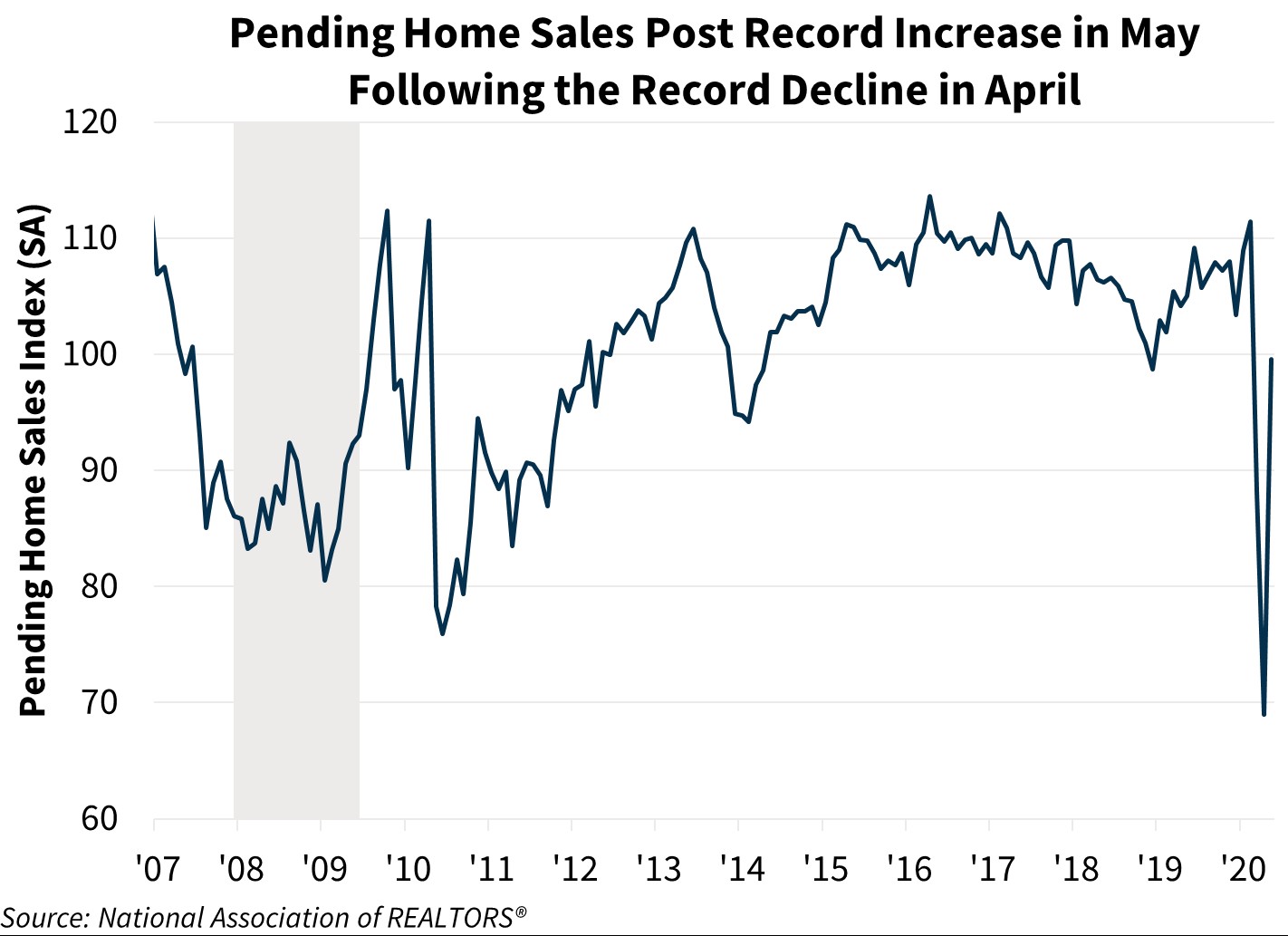Labor Market Recovers Further in June
Key Takeaways:
- The minutes from the Federal Open Market Committee’s June 9-10 meeting show that participants expect “personal consumption expenditures to grow strongly in the second half of the year” given supportive monetary and fiscal policies. The CARES Act in particular should provide support for the next few months, though its expiration creates uncertainty and the risks for businesses remain high, which has weighed on capital expenditures.
- Nonfarm payroll employment jumped by 4.8 million in June, according to the Bureau of Labor Statistics, the second straight monthly gain, though still over 13 million payrolls lower than the March level. Over half of June’s increase was in the leisure/hospitality and retail trade sectors. The unemployment rate dropped 2.2 percentage points to 11.1 percent, though it remains 7.6 percentage points above its February level. Average hourly earnings increased 5.0 percent year over year, a slight deceleration from May, reflecting a compositional shift in employment back toward hourly wage workers. Residential construction employment (which includes specialty contractors) increased by 83,200 jobs.
- The Conference Board Consumer Confidence Index jumped 12.2 points in June to 98.1, the largest increase since November 2011, but well below early 2020 highs. While consumers’ confidence in the present situation increased by a larger amount over the month than consumer expectations, the latter remains much closer to pre-COVID levels.
- Light vehicle sales rose 8.1 percent to a seasonally adjusted annualized rate (SAAR) of 13.2 million units in June, according to Autodata. During the second quarter, sales fell for the third consecutive quarter to a SAAR of 11.3 million units, the lowest level in 10 years.
- The ISM Manufacturing Index increased 9.5 points in June to 52.6, the first reading above 50 since February (any reading above 50 indicates expansion). The rise was driven by a record increase in the new orders index and the second-largest increase on record in the production index, which both rose above 50 for the first time since January and February, respectively.
- According to the Census Bureau, the real goods trade deficit (an input into the calculation of net exports) narrowed by approximately $6.0 billion to $86.5 billion in May as exports and imports fell 5.9 percent and 0.4 percent, respectively.
- Factory orders rose 8.0 percent in May, according to the Census Bureau, while factory shipments rose 3.1 percent. Both new orders and shipments of nondurable goods increased 2.0 percent.
- The National Association of REALTORS® Pending Home Sales Index, which records contract signings of existing homes and typically leads closings by one to two months, jumped by a record 44.3 percent in May to 99.6. From a year ago, pending sales fell 5.1 percent.
- New private residential single-family construction spending dropped 8.5 percent, the largest decline since February 2009. Spending on new multifamily construction rose 2.3 percent, while home improvement spending ticked up by just 0.1 percent.
Forecast Impact
Most economic data in June showed further evidence of a rebound as the economy began reopening in earnest. The second straight month of increase in payroll employment in June shows that the reopening process is allowing more and more people to return to work, with the leisure/hospitality and retail trade sectors showing a solid rebound. Given the increase in employment and the general reopening across the country, the partial rebound in consumer confidence in June was expected and bodes well for consumer spending. The increase in June auto sales supports our forecast for growing consumer spending heading into the third quarter. The expansion of manufacturing activity in June was also likely driven by the reopening process, and the increase in new factory orders suggests some support to business fixed investment. However, much of this data reflect the period before the recent surge in new coronavirus cases across the country. Many states, counties, and cities have begun to either slow or reverse their current pace of reopening, which could lead to further declines in employment and confidence in the coming months if cases continue to rise. In housing, the record increase in May pending home sales suggests that existing sales will continue to increase through July. However, limited housing supply and a resurgence in new virus cases will likely weigh on sales going forward.


Economic and Strategic Research Group
July 2, 2020
Opinions, analyses, estimates, forecasts and other views of Fannie Mae's Economic and Strategic Research (ESR) Group included in these materials should not be construed as indicating Fannie Mae's business prospects or expected results, are based on a number of assumptions, and are subject to change without notice. How this information affects Fannie Mae will depend on many factors. Although the ESR group bases its opinions, analyses, estimates, forecasts and other views on information it considers reliable, it does not guarantee that the information provided in these materials is accurate, current or suitable for any particular purpose. Changes in the assumptions or the information underlying these views, including assumptions about the duration and magnitude of shutdowns and social distancing, could produce materially different results. The analyses, opinions, estimates, forecasts and other views published by the ESR group represent the views of that group as of the date indicated and do not necessarily represent the views of Fannie Mae or its management.
